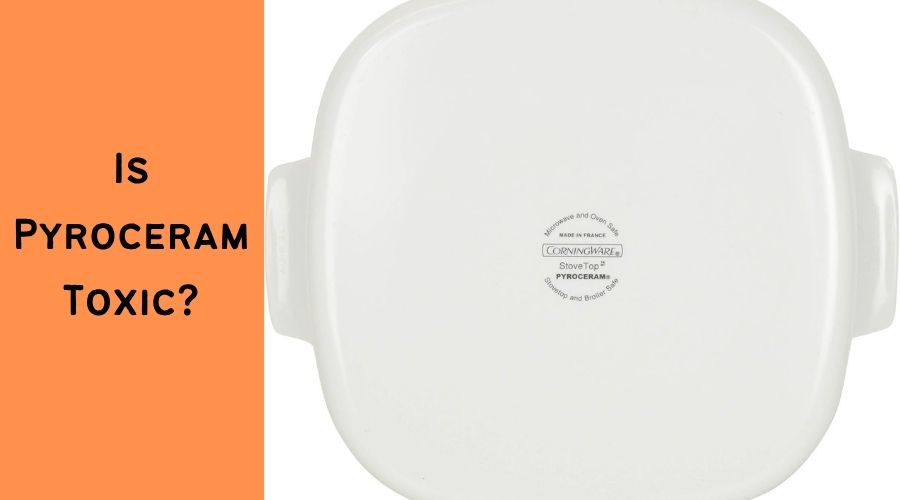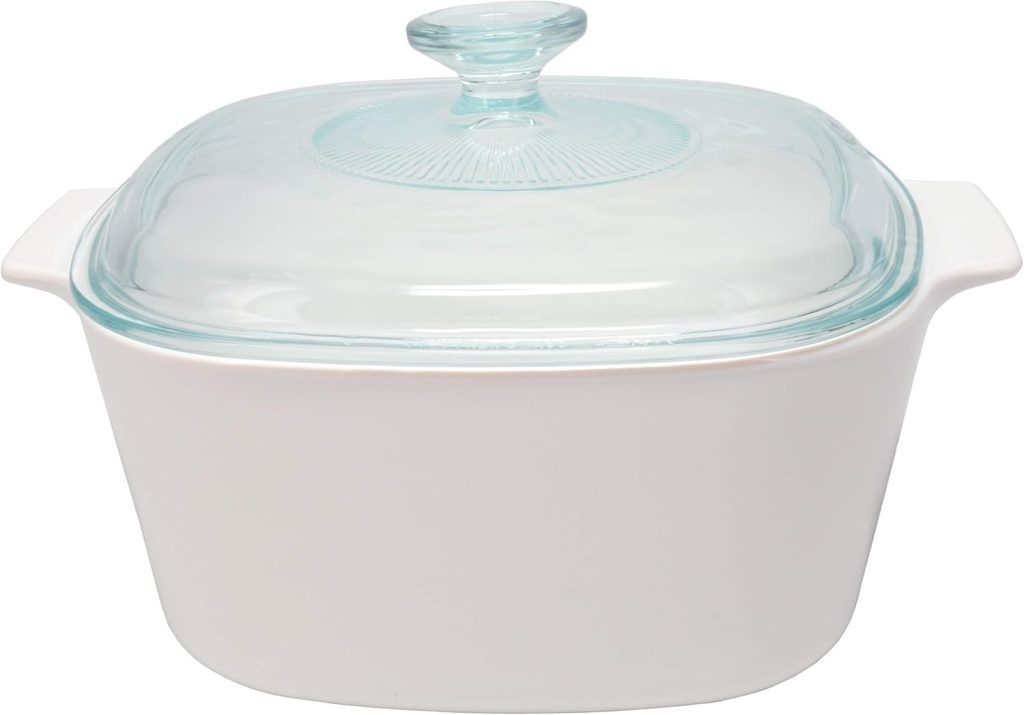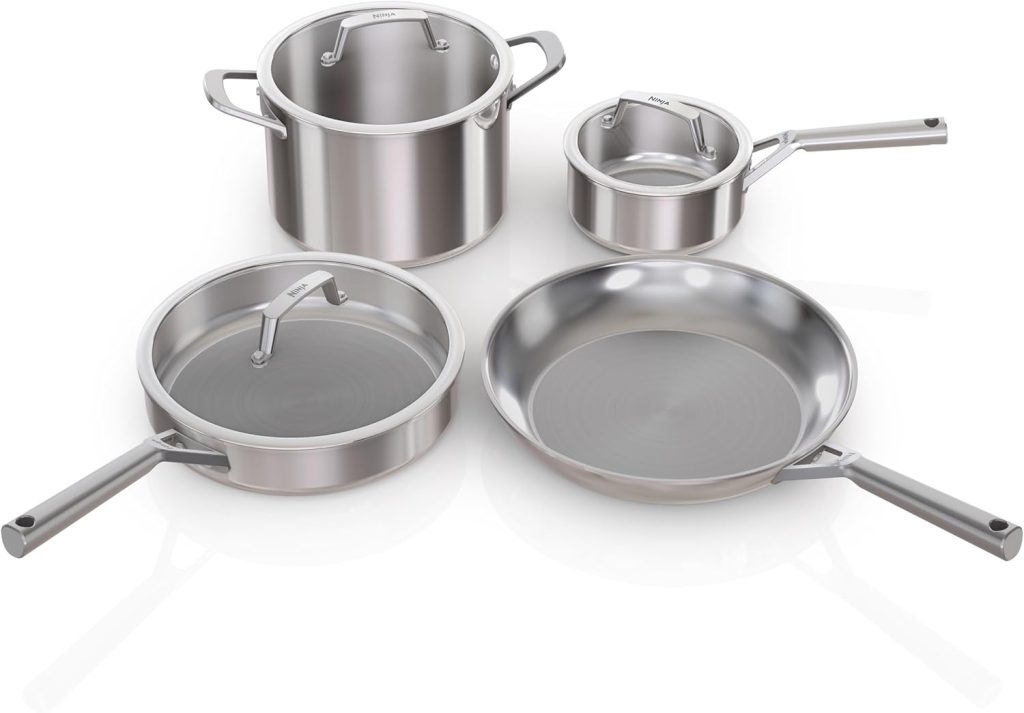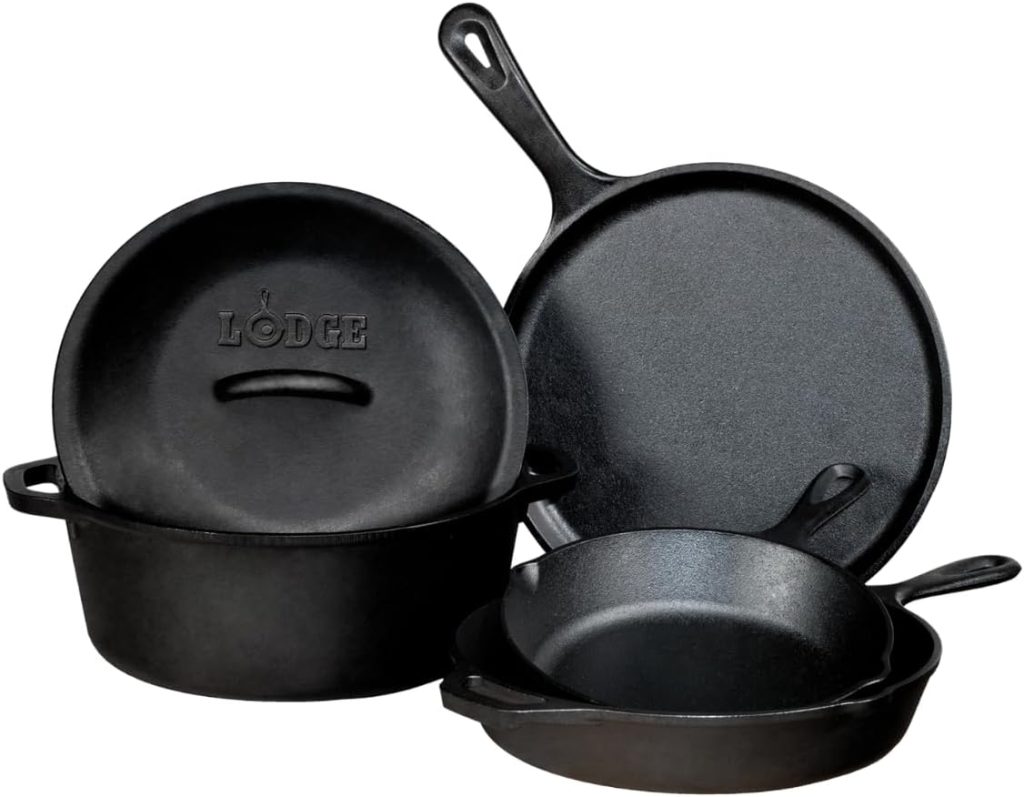Many homeowners worry about the safety of their kitchen cookware, especially vintage pieces. Is Pyroceram toxic?
This question comes up frequently among people who own Corning Ware dishes or are considering buying them.
Pyroceram is the special glass-ceramic material that Corning uses to make their famous white cookware with colorful patterns.
The good news is that Pyroceram is safe for cooking and food storage.
However, understanding why it’s safe and how to use it properly can help you make informed decisions about your cookware.
This guide will cover everything you need to know about Pyroceram safety, from its chemical makeup to proper care instructions.
QUICK ANSWER: IS PYROCERAM TOXIC?

Pyroceram is not toxic and is considered safe for food contact. This glass-ceramic material used in CorningWare contains no harmful chemicals, and does not leach toxins into food when used properly. Scientific testing confirms Pyroceram’s safety for cooking and food storage.
WHAT IS PYROCERAM? UNDERSTANDING THE MATERIAL
Pyroceram is a special type of glass-ceramic material developed by Corning Inc. in the 1950s. Unlike regular glass or ceramic, this material combines the best features of both.
The main ingredient in Pyroceram is lithium aluminosilicate. This scientific name might sound scary, but it’s actually a very stable and safe compound.

Think of it like a super-strong type of glass that won’t break easily from heat changes.
Corning created Pyroceram through a careful manufacturing process. First, they make special glass.
Then, they heat it in a controlled way to create tiny crystals inside. These crystals make the material much stronger than regular glass.
Here’s what makes Pyroceram special:

- It can go from freezer to oven without breaking
- It doesn’t absorb food odors or stains
- The surface is completely smooth and non-porous
- It handles temperature changes from -40°F to 500°F
Since 1958, Corning has used Pyroceram to make millions of cookware pieces. You might know them as CorningWare dishes with patterns like Blue Cornflower or Spice of Life.
The same material also gets used in laboratory equipment and even telescope mirrors because it’s so stable and reliable.
The key point is that Pyroceram isn’t just any ceramic or glass. It’s a specially engineered material designed to be safe around food and to last for decades.
RELATED : CORNINGWARE CORELLE KITCHEN GLASSWARE PRODUCTSPYROCERAM SAFETY PROFILE: SCIENTIFIC EVIDENCE
According to the FFDCA on food contact material regulations USA, Pyroceram-based products are consistent with food contact safety requirements established since the mid-20th century.
Here’s what the science tells us about Pyroceram safety:
Chemical Inertness
Pyroceram is chemically inert, which means it doesn’t react with food or drinks. Even acidic foods like tomatoes or citrus won’t cause the material to break down or release chemicals.

This is different from some metals that can react with acidic foods.
No Heavy Metals
Extensive laboratory testing using X-ray fluorescence (XRF) analysis has shown that Pyroceram and its related glass-ceramic cookware (such as Corning Visionware and Visions products) consistently test as “Non-Detect” for lead (Pb), cadmium (Cd), and mercury (Hg).
“Non-Detect” means that the concentration of these heavy metals is below the detectable limits of the instrument used for testing, which are designed to catch even trace levels considered potentially harmful in cookware.
| Heavy Metal | Laboratory XRF Test | Used in Manufacturing | Notes |
| Lead (Pb) | Non-Detect | No | Not used in process or product |
| Cadmium (Cd) | Non-Detect | No | Not used in process or product |
| Mercury (Hg) | Non-Detect | No | Not used in process or product |
Temperature Stability
According to Thermtest instruments, Pyroceram can withstand extremely high temperatures, far exceeding those used in standard kitchen applications, with operational ranges cited up to 1,256°F (680°C).
This means it will not degrade, release harmful vapors, warp, or chemically break down under normal stovetop, oven, or broiler use.
This makes it safer than some non-stick coatings that can release fumes at high heat.
| Feature | Pyroceram | Non-Stick Coatings (PTFE/Ceramic) |
| Max Safe Temperature | Up to 1,256°F (680°C) | ~500°F (260°C) for PTFE |
| Fume/Chemical Emission | None at cooking temps | PTFE releases fumes if overheated |
| Chemical Stability | Inert, does not break down | PTFE degrades at high temp |
| Maintenance of Properties | Retains structure at high heat | Non-stick can lose effectiveness |
Non-Porous Surface
Unlike some ceramics that have tiny holes, Pyroceram has a completely smooth surface. Bacteria and food particles can’t get trapped inside. This makes it more hygienic than porous materials.
Long-Term Safety
Studies of Pyroceram pieces from the 1960s show that the material doesn’t degrade over time. Properly cared for pieces remain just as safe as new ones.
Independent testing laboratories have also studied Pyroceram. These tests confirm that the material meets all current food safety standards.
Even after decades of use, well-maintained Pyroceram pieces pose no health risks.
COMMON HEALTH CONCERNS ADDRESSED
Many people have specific worries about Pyroceram safety. Let’s address the most common concerns with facts.
Lead Content Worries
The biggest concern people have is about lead. Some ceramic dishes from other countries do contain lead, which can be dangerous.
However, Pyroceram is completely different. The manufacturing process doesn’t use lead at any stage. Independent testing confirms zero lead content in Pyroceram products.
If you’re still worried about lead content specifically, you might want to learn more about corningware lead testing methods and regulations.
Microwave Safety Questions
Pyroceram is microwave-safe when used correctly. The material doesn’t contain metals that could spark or cause problems.
However, always check that your specific piece is labeled as microwave-safe, especially with vintage items.
Chemical Leaching Fears
Some people worry that heat might cause Pyroceram to release chemicals into food. Scientific testing shows this doesn’t happen at normal cooking temperatures.
The material remains stable up to 500°F, which is higher than most home cooking needs.
Breakage Safety
While Pyroceram is very strong, it can still break if dropped or subjected to extreme temperature shock. Broken pieces won’t release harmful chemicals, but sharp edges can cause cuts.
Always inspect your cookware for chips or cracks.
Comparison to Problematic Materials
Pyroceram is much safer than some vintage ceramics that might contain lead or other harmful substances. It’s also safer than non-stick coatings that can release fumes when overheated.
PYROCERAM VS. OTHER COOKWARE MATERIALS
Understanding how Pyroceram compares to other cookware helps put its safety in perspective.
Stainless Steel

Both Pyroceram and quality stainless steel are very safe choices. Stainless steel is more durable against drops, unlike Pyroceram. Both are non-reactive with food.
Traditional Ceramics

Regular ceramic cookware can be safe, but quality varies widely. Some ceramic pieces contain lead or have porous surfaces that harbor bacteria. Pyroceram offers more consistent safety and quality.
Non-Stick Coatings
Non-stick pans can release harmful fumes when overheated. Pyroceram doesn’t have this problem. It also lasts much longer than non-stick surfaces, which wear out over time.
Regular Glass
While glass cookware like Pyrex is generally safe, it’s not as strong as Pyroceram. Regular glass is more likely to break from temperature changes or impacts.
Cast Iron

Cast iron is safe when properly seasoned, but it requires more maintenance. Pyroceram is much easier to care for and clean.
For safety ranking, Pyroceram falls into the top category along with stainless steel and quality glass. It’s much safer than aluminum, non-stick coatings, or questionable ceramic imports.
PROPER USE AND MAINTENANCE FOR SAFETY
Following proper use and care guidelines keeps your Pyroceram cookware safe and functional for decades.
Temperature Guidelines
Never subject Pyroceram to extreme temperature changes. Don’t put a hot dish directly into cold water or take a frozen dish straight to a hot oven. Let items come to room temperature first, or use gradual temperature changes.
The safe temperature range is -40°F to 500°F. This covers all normal cooking needs, but don’t use Pyroceram under broilers or on stovetops unless specifically designed for it.
Cleaning Best Practices
Wash Pyroceram with warm, soapy water. Avoid abrasive cleaners that could scratch the surface. For stubborn stains, use baking soda paste or specialized cookware cleaners.
Never use steel wool or harsh scrubbers on Pyroceram. The smooth surface cleans easily with gentle methods.
Regular Inspection
Check your Pyroceram pieces regularly for damage. Look for chips, cracks, or deep scratches. Small surface scratches are usually just cosmetic, but deep damage could affect safety and performance.
Hold pieces up to the light to spot hairline cracks that might not be visible otherwise.
Storage Tips
Store Pyroceram pieces carefully to prevent chips and cracks. Use padding between stacked pieces. Avoid storing heavy items on top of Pyroceram dishes.
Keep lids and dishes together when possible to prevent mixing up pieces from different sets.
VINTAGE VS. MODERN CORNINGWARE SAFETY
Both vintage and modern Pyroceram pieces are safe, but there are some differences to know about.
Manufacturing Consistency
Modern quality control is more stringent than in earlier decades. However, vintage Pyroceram pieces made by Corning still meet safety standards. The basic material and process haven’t changed significantly.
Pattern Considerations
The decorative patterns on CorningWare are applied over the Pyroceram base. Some very old patterns might use different materials, but the Pyroceram underneath is still safe.
Popular patterns like Blue Cornflower and Spice of Life have been tested and confirmed safe.
Age-Related Changes
Well-maintained vintage Pyroceram doesn’t become unsafe with age. The material is very stable over time. However, older pieces might have accumulated damage from years of use.
Collector Guideline
If you collect vintage CorningWare, focus on pieces without chips, cracks, or deep scratches. Clean pieces gently and store them carefully.
Most vintage pieces are perfectly safe for actual cooking use, not just display.
Value vs. Safety
Some rare vintage pieces might be too valuable to use for cooking. This is a personal choice, but from a safety standpoint, there’s usually no problem using well-maintained vintage Pyroceram.
RED FLAGS: WHEN PYROCERAM MAY BE UNSAFE
While Pyroceram is generally very safe, certain conditions can make it risky to use.
Visible Damage Signs: Cracks, chips, or deep scratches can be safety hazards. Damaged Pyroceram is more likely to break completely during use. Sharp edges from chips can cause cuts.
Don’t use pieces with cracks that go all the way through. These can break apart suddenly, potentially causing burns or cuts.
Extreme Temperature Damage: If a piece has been subjected to extreme heat (like a house fire) or dramatic temperature shock, it might have invisible damage. When in doubt, don’t use it.
Counterfeit Products: Some fake Corning Ware pieces are made with inferior materials. These might not be as safe as genuine Pyroceram. Buy from reputable sources and look for authentic Corning markings.
Age-Related Degradation: While Pyroceram doesn’t degrade chemically, very old pieces might have accumulated enough small damage to become unreliable.
Use your judgment about pieces that seem fragile or worn.
EXPERT OPINIONS AND REGULATORY STANCE
Food safety experts and regulatory agencies consistently rate Pyroceram as safe for food contact.
Consumer Product Safety Commission (CPSC) testing and records confirm that properly made Pyroceram cookware meets all safety requirements for food contact materials and is not subject to current recalls or warnings. The recalls associated with Pyroceram concern specific early production defects in CorningWare percolators, not the safety of Pyroceram as a food contact material or cookware category as a whole.
Food Safety Expert Recommendations: Nutrition and food safety professionals often recommend Pyroceram as one of the safer cookware options available. It ranks alongside stainless steel and quality glass in expert recommendations.
International Standards: Pyroceram meets safety standards in Europe, Canada, and other countries with strict food safety regulations. This international acceptance confirms its safety profile.
Scientific Community Consensus: Material science researchers who study cookware safety consistently classify Pyroceram as a low-risk material for food contact use.
ALTERNATIVES TO PYROCERAM COOKWARE
If you prefer alternatives to Pyroceram, several other safe options are available.
Borosilicate Glass: High-quality borosilicate glass (like Pyrex) offers similar benefits to Pyroceram. It’s thermal shock resistant and chemically inert. However, it’s not quite as durable as Pyroceram.
High-Quality Ceramic: Well-made ceramic cookware from reputable manufacturers can be very safe. Look for pieces that are lead-free and have non-porous glazes. Quality varies more widely than with Pyroceram.
Stainless Steel: Stainless steel is an excellent choice for cookware safety. It’s durable, non-reactive, and easy to clean. The main downside is that it’s not suitable for microwave use.
Cast Iron and Carbon Steel: These traditional materials are safe when properly seasoned and maintained. They require more care than Pyroceram but can last for generations.
The key is choosing cookware from reputable manufacturers who follow safety standards. Avoid very cheap imports that might not meet safety requirements.
CONCLUSION AND KEY TAKEAWAYS
Pyroceram is not toxic and remains one of the safest cookware materials available.
Scientific evidence, regulatory approval, and decades of safe use confirm that Pyroceram poses no health risks when used properly.
The main safety points to remember are:
- Pyroceram contains no lead, cadmium, or other harmful metals
- It doesn’t leach chemicals into food at normal cooking temperatures
- The material is FDA-approved and meets international safety standards
- Both vintage and modern pieces are safe when undamaged
- Proper use and maintenance ensure continued safety
If you own Corning Ware or are considering buying some, you can feel confident about using it for cooking and food storage. Just follow basic care guidelines and inspect pieces regularly for damage.
For those with specific concerns about lead content, additional testing information is available. The key is understanding that quality cookware from reputable manufacturers like Corning prioritizes consumer safety.
Pyroceram has earned its reputation as safe, durable cookware through rigorous testing and decades of reliable performance.
Whether you’re using a vintage piece from the 1960s or a modern Corning Ware dish, you can cook with confidence knowing that the Pyroceram material meets the highest safety standards.